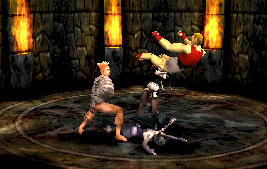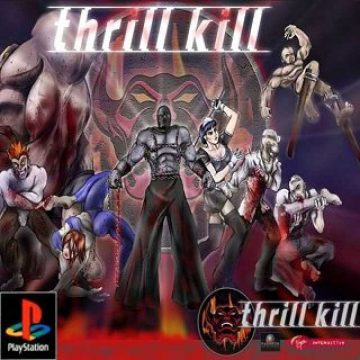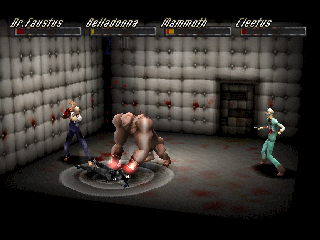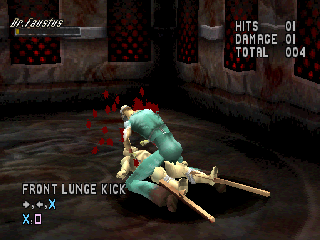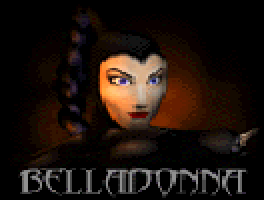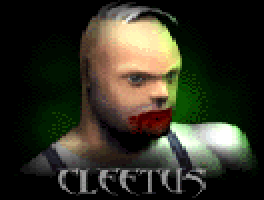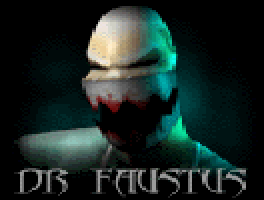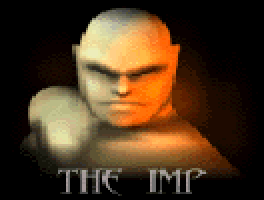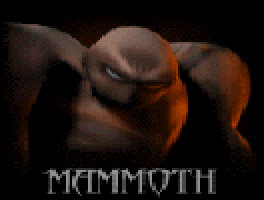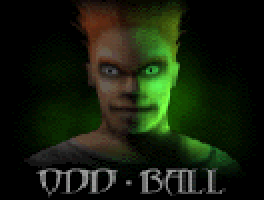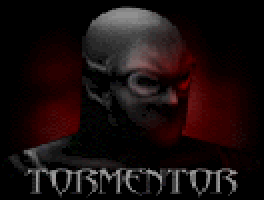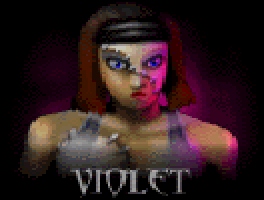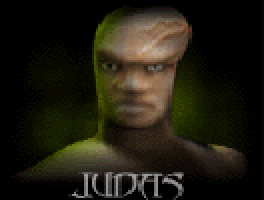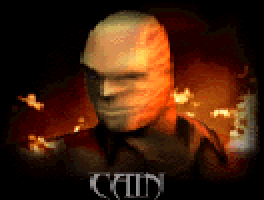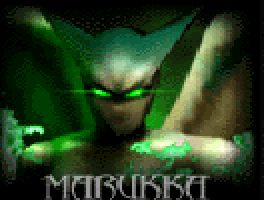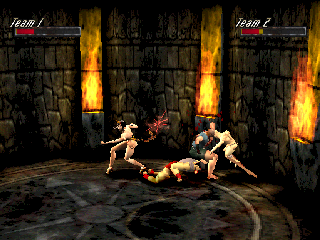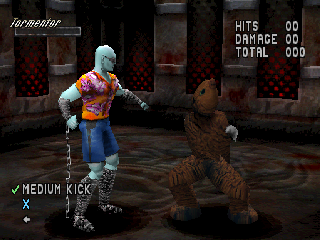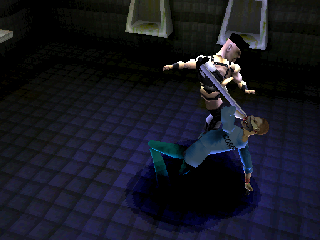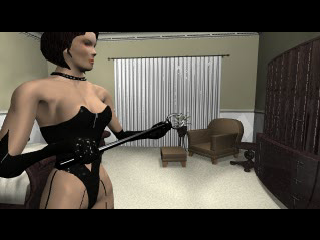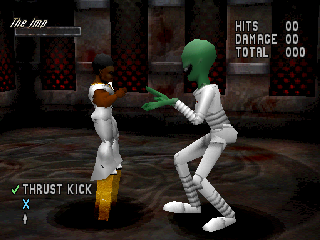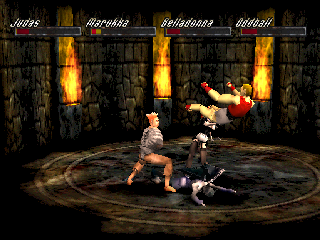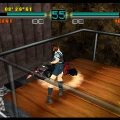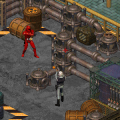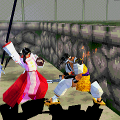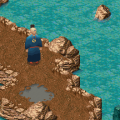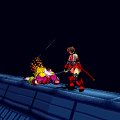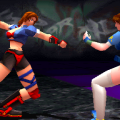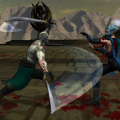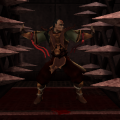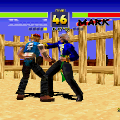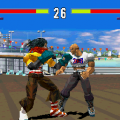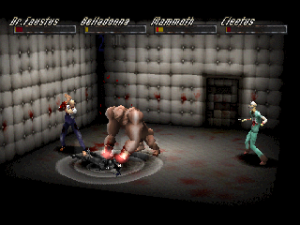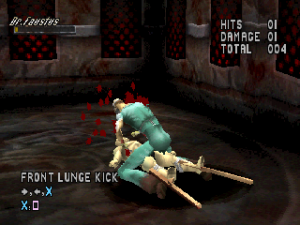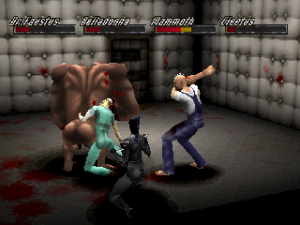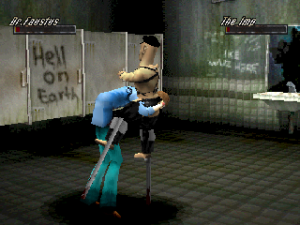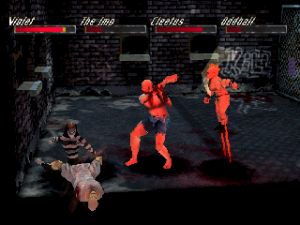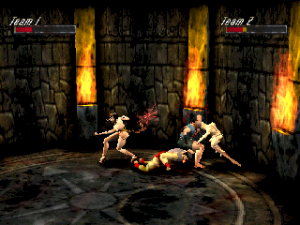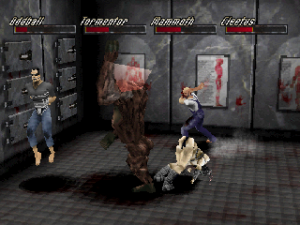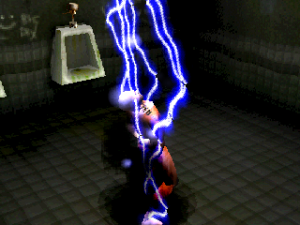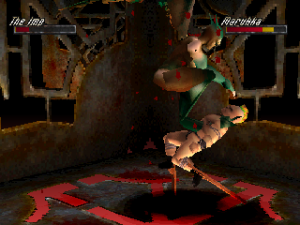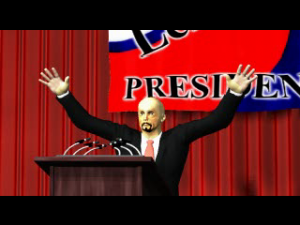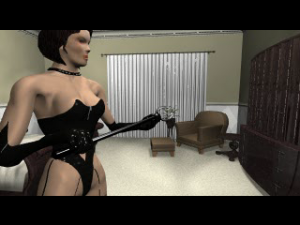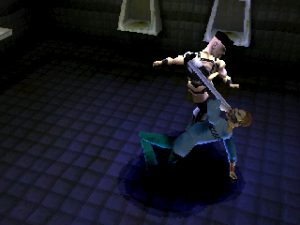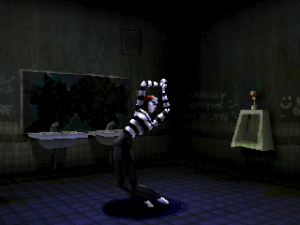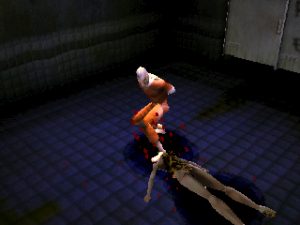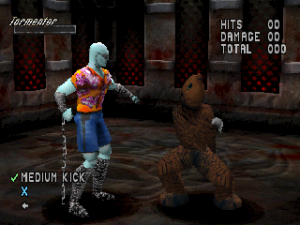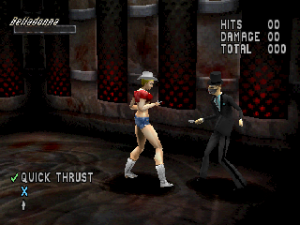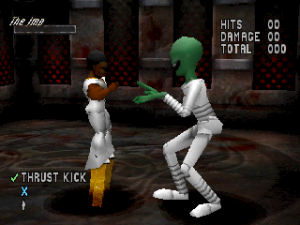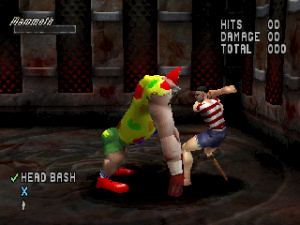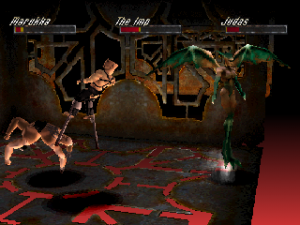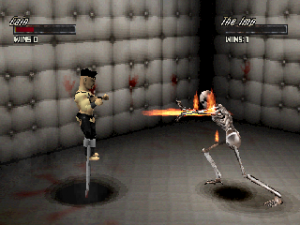Far, far too many games over the years and through the history of gaming have ended up cancelled, never to see the light of day. Rarely, however, some of these games end up being released to the public, leaving the general public to get a chance to finally try it for themselves. Some of these games had so much time put into them that they seem just about complete, with only a few finishing touches being needed before they could have hit store shelves. Thrill Kill is one of these games, a promising looking fighter suddenly cancelled only six weeks before its scheduled release date.
The game had a planned release date of October 1998, which would have beaten Power Stone 2 as the first four player 3D arena brawler by almost two years. Before the game saw release, however, its publisher, Virgin Interactive, was bought out by Electronic Arts. Having truly begun their start of darkness by now, EA quickly cancelled the game, claiming that its intense violence would go against its family friendly image. This was despite of the fact that it had already gotten coverage from several gaming publications, with PSM Magazine having gone as far as to print out a move list for the game. Normally, when this sort of thing happens, it generally fades from gaming history entirely. However, the game somehow ended up on the internet, although how exactly it happened was long forgotten. From there, the game slowly spread across the internet, and with a little help from mod chips and emulation, the game ended up being released, in at least one form, after all.
Thrill Kill offers one of the standard fighting game plots of “A bunch of people died, now somebody has put them all together so they can go beat each other up”. This kind of plot is actually surprisingly common for fighting games, showing up in games like Eternal Champions, Pray for Death, and Fight for Life, but the twist here is that the nine playable characters are all actually in Hell. See, they’re all actually very bad people, who’ve done some very bad things, and everybody would probably be much better off if they stayed there. As happens in these sort of plots, a demon named Marukka starts a fighting tournament, with the winner being offered a second chance at life. You think one of these tournament organizers would try this through an organized debate, or something, but this is Hell, to be fair.
The game itself doesn’t tell you any of this, however, and If you don’t know anything about the plot before you play, it’ll basically just look like a bunch of BDSM enthusiats beating each other up in tiny rooms. Which isn’t far from what it really is, to be entirely honest. In fact, pretty much all of the plot is left in what was going to be the instruction manual, which seems to have been lost to time. (The information shown on the character descriptions below was taken from Fuzzd0rk’s Thrill Kill fansite.)
Characters
Belladonna
A librarian in life, Belladonna killed her husband and sister after finding out they were cheating on her together, before accidentally electrocuting herself in the bath. Belladonna is basically here to appeal to about twenty different fetishes at once, and she’s so hypersexualized that she makes any of the Mortal Kombat ladies look like nuns in comparison. Her costumes range from things like BDSM wear to a maid outfit, a large majority of her moves involve either her crotch or somebody else’s crotch, and her intro pose has her moaning and rubbing herself. Yes, it’s about as awkward as you’d imagine it might be.
Cleetus
A redneck cannibal, who ended up dying from an infection from the human flesh he ate. He carries around a severed leg which he whacks people with, and has plenty of moves that let him chomp his opponents a lot, as well. There’s not really much to say about Cletus, compared to Belladonna. In most other games, a redneck cannibal would be a pretty weird character choice. Here, he’s probably one of the blander ones.
Dr. Faustus
No, the evil, balding surgeon who uses a lot of weird and confusing moves in combat has nothing to do with the Guilty Gear character. Really. Faustus was a plastic surgeon who murdered and disfigured all of his patients, before dying due to the giant bear trap he grafted onto his face. You’d imagine being a doctor, he would have foreseen something like this. He stabs opponents a lot with his scalpel, chews up people with his steel mouth, and spins like a ballerina to swap places with opponents. He’s honestly pretty fun to play as, just for all his weird moves and how much he seems to be enjoying himself.
The Imp
Another contender for the most “Trying a little too hard, there, guys” character of the game, Imp is an evil midget. That’s basically his entire character, as he’s a midget who hates tall people. In another example of people sticking things onto themselves when they probably shouldn’t have, the infection he got from grafting stilts onto his legs killed him. Curiously, it’s never stated that he actually ever murdered anybody, much like the rest of the cast did. Maybe he just hated tall people really hard. He uses his stilts to smack people around with, and somehow manages to keep his balance just as well as the other characters.
Mammoth
The biggest character in the game, Mammoth can basically be described as a skinless gorilla. He used to be a postal worker in life, because this was made in the time when jokes about angry postal workers were still funny. He went on a rampage after being fired, more than likely because somebody noticed he’s a giant, skinless gorilla. After that, he shot himself and ended up in this game, as the obligatory ‘slow but strong’ character.
Odd Ball
An FBI profiler who ended up becoming a serial killer himself, before ending up gunned down by another FBI agent. He also doesn’t have any arms, either because they’re bound up or amputated entirely. He does pretty well for himself, however, since he has a lot of kicking and headbutting attacks, along with a few rad breakdancing moves. He’s got one interesting move where he sits himself on the floor, where he can hop around or go into an attack. He also constantly mumbles something that sounds like “They love me”. Creepy.
Tormentor
A former judge who ended up executed after it was found out he acquitted criminals just to find them and torture them later. Tormentor is basically Belladonna Lite, keeping some of the bondage overtones while thankfully dropping the crotch fixation. He’s honestly one of the more boring characters in the game, giving that all he really has for a gimmick is ‘chains and punching people’. He doesn’t try eating anybody or anything.
Violet
A circus contortionist, who, after killing a male attacker in her dressing room, grew a hatred for men. She later ended up dying from a spinal cord rupture. She’s got some interesting moves with her contortionism, and she’s a lot less… uncomfortable, for lack of a better word than Belladonna. Of course, this isn’t the game you want to go to for realistic, sensitive portrayals of female characters, but still.
Judas
So here’s a Siamese twin with one brother sharing each end of the same torso. Straight to hell they go, then! Despite the non-existant reasoning on why they’re in hell, this is actually a pretty cool design for a subboss. They’ve also got an interesting gimmick where hitting a punch or kick buttons will make the other twin flip over and be the ‘top’ half. It’s an interesting idea, if a little confusing In practice. Also, for whatever reason, one of their outfits is basically Ryu & Ken.
Cain
Cain was an arsonist, who ended up getting himself burnt alive after burning down a building. Going by his ending FMV, however, this apparently didn’t kill him. Instead, he ended up constantly wreathed in flames, which gives him just a little more reach than almost any of the characters in the game. Also, one of his moves makes him shoot a jet of fire out of his rear, complete with an agonized scream. This is the game that was supposed to be more shocking than any previous Mortal Kombat. Remember that.
Marukka
A demon from hell that’s also supposedly “The Goddess of Secrets”. Apparently, she got bored one day and decided to have a bunch of dead people fight for her amusement, which is how the whole tournament starts. She’s also the final boss of the arcade mode, and she’s a pretty rough challenge. Also, she can teleport, which is leagues beyond something like an angry contortionist can do.
The characters themselves are pretty unique, and some of their concepts, even if they’re a little eye-rolling nowadays, are certainly unique for the time. It’s an interesting twist from most fighting games, where the characters either have great supernatural power, or advanced martial artists skills. Here, you’ve just got a bunch of weirdos beating the crap out of each other with severed legs, cattle prods, and other improvised weaponry. Some of the moves the characters have look pretty brutal, as well, like one where Cleetus will pin down his foe and start chowing down on them right there, or how Violet can bend people in ways people just don’t bend. It’s also interesting how here, Hell isn’t pictured as your usual fire and brimstone deal except for the final stage. In fact, it’s more like a particularly grody city more than anything, complete with a back alley some guy just got murdered in. Overall, it’s got a very gritty style to it, much more than any Mortal Kombat. It can hardly be described as mature as the game likes to think it is, of course, but it’s certainly got an interesting look to it.
While Mortal Kombat was all about the blood, gore, and a few skimpy outfits here and there, Thrill Kill ratchets the blood and sexuality to ridiculous levels. In the wake of games like Postal 2, it’s actually a lot tamer now, but in the time of the PlayStation, this was the sort of stuff that could earn you an Adults Only rating. You’ve got themes of sexuality, BDSM, and even cannibalism, all sorts of things that soccer moms would have their heads explode over. The game is so positive it’s going to offend your sensibilities that upon booting the game up, you’re given a disclaimer about all the nasty sorts of things that go on in this game. You’re then given two choices: Continue on with the game, or press the Circle button to shut it down and keep your innocence intact.
To be honest, in terms of actual violence content, it’s not all that much worse than Mortal Kombat 4, which had come out a year earlier. There’s plenty of blood, to be sure, and some of the the fatalities are pretty brutal. It’s definitely not a game you’d want children playing, there’s no denying that. But compared to games like Manhunt or Postal 2, it tends to look a lot tamer nowadays. Most of the really objectionable content probably comes from the game’s other themes, like having a dominatrix who constantly rubs herself. In fact, there’s a censored version of the game floating around the internet which changes a few things, most likely in an attempt to avoid an AO rating. It probably could have even seen release, if it weren’t released by EA, whose most violent game that year was Jurassic Park: Trespasser.
The basic button setup isn’t entirely unlike Tekken, with four attack buttons controlling each of your character’s arms or legs. That is, if your character happens to have any arms, at least. You can also crouch, letting you perform low attacks that can hit prone as well as standing opponents. Blocking is done by standing still, like Tekken, but there’s also a button you can hold down to keep guarding, similar to the Mortal Kombat games. This is pretty handy, though, since given how chaotic the action gets, you won’t always be able to stand still, nor is which direction is “backward” always clear. Every character has a few three to four hit combos performed by hitting the attack buttons in certain combinations, much like how you’d perform a basic combo in Tekken, and performing these will generally do a decent chunk of damage and send your opponent flying off, giving you a little breathing room.
Characters can also perform a quick dash by double tapping in any direction, and they all get a few extra attacks that can be performed right after. If you ever get knocked down, every character gets a handful of moves that hit nearby opponents from a prone position. Every character also gets four universal throws, with two inflicting quick damage on your opponent. The other two throws are meant to be used a little more strategically, with the Swap Throw letting you trade places with your opponent, and the Hold Throw has you pinning your opponent in front of your character, leaving your foes open for somebody to beat on them. Finally, every character gets two counter moves, which make your character go into a stance for a moment. There’s a high counter and a low counter, and if you manage to have an opponent hit you with the right attack while you’re in the counter stance, you’ll send them hurtling away and inflict some damage. It’s not all that useful in actual practice, since the action gets too hectic in a four-player brawl, but it might be useful in a 1v1 match if you can guess what your opponent might pull.
The actual fighting system is closer to something like Tekken or Virtua Fighter than Mortal Kombat, mostly because, with very few exceptions, none of the characters have any ranged weapons. Sure, you’ve got characters who use weapons, but for the most part, the fighting is strictly hand-to-hand. That’s not to say that there’s not some surprises, since you’ve got people who contort themselves, hit people with a disembodied leg, and a crazy doctor who chews people’s faces off. In gameplay terms, the characters mostly feel similar, although they all have at least a few unique moves to their name. Every character has a set of moves that perform the same function, however, which is where the similarities come in. Some moves work good as crowd control, slamming either one player or all of them into a nearby wall to give you a little breathing room. Other moves can land a lot of hits on multiple opponents, meaning you can rack up more damage the more people you’ve got hanging around you. Some moves will also launch your opponents into the air, and with good timing, you can land a few more attacks on somebody before they hit the ground for extra damage. You’ve also got a few command throws in addition to your normal ones, which can do big damage to a single opponent, or sometimes more than one, in some cases.
The special move inputs are a bit of a combination of Street Fighter‘s and Mortal Kombat‘s. Some moves are done with quarter circles and 360’s, while you can do others with “back, back, forward, button” motions. The game doesn’t count diagonals, however, which is useful for all the half circles and 360 motions some of the moves require. The really weird thing, however, is that the actual directions you input don’t really matter that much. For example, if you have a move that requires a quarter circle motion, that can be a quarter circle in any direction. Down forward, down back, or even up forward or up back, they all work as long as it’s a quarter circle n some direction. This is pretty handy, since characters move and turn so much you’re never going to be facing in the same direction for too long. Given that the fighting is hand to hand, more of the special moves are powerful attacks that can stun opponents or send them flying, stance moves, command grabs, and the like, than the stuff you’d see in Street Fighter.
In most fighting games, you win matches by reducing their health bar to zero, but Thrill Kill actually has what’s basically the opposite of a health bar. Each player has a “Kill Meter” that starts off empty at the start of each round. Any time a character lands hits on another, part of their meter starts to build up, with more meter being earned depending on the strength of the attack. Once a character fills their meter all the way, they get a hellish red glow around them, sending all the other players flying back. Once somebody has the glow, they can hit any attack button to attempt to grab one of the other players. If you’ve got the glow, you’ll want to dash in towards somebody and grab them as quickly as it can. If it happens to somebody else, you’ll want to get the hell out of the way, and make use of your Swap Throw to put other players between you and the guy with the glow.
If you manage to grab a character before your Kill Meter completely empties, you’ll use one of the four “Elimination Kills” that all characters share. Depending on which button you hit, you’ll pull off a quick fatality, like decapitating your opponent, or punching them so hard they explode into pieces. Once a character is eliminated from a match, a new round starts, with the winner of the previous round getting a small boost to their meter. If you don’t kill somebody before your meter runs out, however, the match resumes where it left off, with the would-be winner having to build their meter back up from the hallway point. If somebody else is about to fill up their meter, this will more than likely end very poorly for you, so don’t waste your chance. Once there’s only two fighters left in the match, however, your character will get shocked with lightning instead of getting the usual glow. It’s at this point you can hold down a certain button combination to select with of your character specific fatalities you’ll perform once you grab the last opponent standing.
Every character has five different finishing moves, with the exception of Violet, who only gets four. The first few are your standard fatality moves, where your character kills off the opponent in some kind of convoluted manner. Some of these can get pretty brutal, even with the rather blocky graphics of the PlayStation. Highlights include convincing your opponent to kill themselves with your own cattle prod, tearing their head off to drink the blood out of it, stomping your opponent through the head so hard it explodes, or looking like you’re about to perform oral sex on your opponent, but it turns out you’re only tickling their feet. Yes, that last one is real, and of course, it’s Belladonna’s. There’s also Thrill KillCombos, which let your character perform a long series of hits on the opponent, leading to full-body explosion. Or, if you’re feeling in more of a Friendship sort of mood, everybody’s last finisher involves your character showing off their dance moves. Belladonna may not be the first nor the last dominatrix to show up in a fighting game, but she is probably the first one you can make perform the Macarena.
The actual mechanics are pretty all right on paper, but the problem is when you have a full set of four players, things get pretty hard to keep track of. The arenas are big enough that the players can split up and fight each other without getting too bunched up, but eventually, everybody will close into one big pile of violence. It’s here where things can be hard to keep track of, or if you’re getting hit, or somebody else is getting hit, until somebody gets flung into the nearest wall. Thankfully, the game is loose enough with targeting so that as long as you’re at least facing in the general direction of somebody, all your attacks will automatically aim towards them, so aiming your hits isn’t much of a priority. There are no extra items and weapons, and no hazards at all in any of the arenas, which mean that the characters have to stay close to each other and keep up the pressure if they want to get anywhere.
The whole “Thrill Kill” meter is an interesting idea, which, for the most part, works pretty well. The way it works means that you can’t just sit back in a corner and let everybody else do the fighting, or else you won’t have the meter you need to get a kill in. On the other hand, however, once somebody has the glow on them, nobody’s safe. If you get killed, even if you’ve been doing pretty well in the round so far, that’s just it. It’s an interesting twist from the standard health meter, though, and gives the game a more hectic ‘party game’ sort of feel. It’s not very deep, sure, but for what it is, it’s more than serviceable, if a little lacking in depth.
The standard arcade mode puts you through eight different stages with your chosen character. Six of these are the standard four player matches. Given how the game works, these aren’t actually all that hard. A lot of the time, the AI opponents will go after each other just as much as they’ll fight you. Even if somebody gets the glow, they’ll only usually grab whoever’s closest to them, and even if that happens to be you, you still have a chance to save yourself by tossing one of the other AI players into their path. The only time you really have to be careful is when you’re down to your last opponent, where you have to be more careful with your moves, since you won’t have any more meat shields to rely on. Since there’s only eight characters unlocked from the start of the game, you’ll encounter the same characters again and again, showing up in different outfits. Still, that’s not really a problem, since the game’s more fun with four players than two.
The sixth stage introduces Cain to the four player matches, who’s only a little tougher than one of the standard combatants. Stage 7 is a one-on-one match against Judas, who’s actually a lot tougher to fight, since he’s got a lot of damaging grabs that he’ll use on you, and you alone. The final stage puts you up against Marukka, who’s an absolute pain to fight. Her biggest problem is that she has a move where she jumps around in the air, spinning around with her wings extended. Every time she does this, you’ll get pushed back further away from her, and if you’re too close, it’ll send you flying backwards and inflict some damage on you. And she will use this move every single chance she gets, along with getting in plenty of counters and grabs. The only real way to fight her is by taking a hit and run style, going for dashing attacks and backing away as quickly as possible. You’re going to end up dying to her a lot, and this is where you’ll be very, very glad you get an unlimited supply of continues.
Once you actually beat Marukka, you’re rewarded for an ending FMV, unless you’re playing as Marukka herself, who gets squat. These are generally short scenes that go a little into each character’s backstory, while usually showing off whatever bad thing they did to deserve going to Hell in the first place. The exception is The Imp, whose ending involves him having a dream where he becomes the president, waking up in bed, and then silently weeping to himself. Fade out. Good grief, did a small person bully the entire development team when they were children, or something? None of the endings are particularly great, considering this is PlayStation-era CGI they’re all made of, but at least they made the effort. You’ll also unlock the boss characters by beating the game once, with the boss arenas only available if you beat the game on Hard and Very Hard difficulty. Not remotely worth it.
The real draw here, however, is the multiplayer. You can either play the game the standard way, or you can play in “Thrill Kill” mode, which only lasts for a single round. There’s also a Team Mode, which splits the players into two teams, if you’re in the mood for a 2v2 or 1v3 match. Here, each team shares a single Kill Meter, so you’ll want to work with your buddy to fill it as fast as you can. If you don’t have a Multitap on hand or a full assortment of players, you can also have CPU players fill up the empty slots. There’s also a training mode, which basically just has you perform all the moves in a character’s moveset. It’s actually worth going through these, as finishing each character’s training mode will unlock an fifth costume for them.
For the system the game it was released on, Thrill Kill looks pretty nice. The characters models are a little jagged, but they’re also recognizable from a distance. The game also keeps a constant frame rate no matter how intense the action gets, which definitely helps for a fighting game like this. As you’d expect, there’s also plenty of blood that spurts out of characters by the bucketful, and it even stains the floor when it eventually lands, which is a nice detail. Most of the stages, however, aren’t really as noteworthy, and most of them are basically just a big, square room with different textures slapped onto the walls to make it look more like an asylum cell, back alley, or dirty bathroom. The sewer level, ironically, is probably the most interesting, as there’s actually flowing water in the background to watch as you fight. What’s also a nice touch is how many alternate costumes the characters get, with every character except for the bosses getting a total of five. Some of these are pretty similar to each other, but the highlight would have to be the fifth costume for each character. These do things like put Belladonna in a cowgirl outfit, make Cleetus into a pirate, or make Violet into a big-headed, stereotypical alien.
The music is mostly industrial and electronic music, a lot of which has a lot of screaming in it. If you’re the sort who likes that sort of genre, you might find a lot to like here, but otherwise, it’s not really noteworthy. The sound effects are pretty good, though, as there’s a lot of rather brutal sound effects for the kinds of things you’ll be inflicting on your foes. There’s pretty much no dialogue from the characters themselves, but they do a lot of convincing screaming, grunting, and gurgling, at least.
While Thrill Kill would never see release, Paradox would eventually put their engine to good use with Wu-Tang: Shaolin Style, which hit store shelves a year later. Here, you have the real-life rap group “The Wu-Tang Clan” represented as a team of martial arts superheroes, which is… a little silly. In terms of gameplay, it’s actually very close to Thrill Kill, with the biggest change being that you now have a standard health bar and a supply of lives. While there’s still plenty of violence, the game is actually censored the first time you boot it up, and requires a code found in the manual to unlock the blood and fatalities – which, among other things, involve ironing your opponent to death, or putting them on a test of strength machine, where the weight goes up so hard it makes them explode. It’s a very silly game.
So, is it that much of a tragedy Thrill Kill was never released? It’s hard to say, really. Wu-Tang would more or less do everything Thrill Kill was trying to do, while still beating Power Stone 2 to the punch. However, Thrill Kill arguably had the more interesting characters and design to it, so something was lost in the transition. Overall, it’s not really the best fighting game out there, nor is it even the best fighting game on the PlayStation, a system that had many. It is, however, ambitious, and unique, and it’s worth remembering for that.
